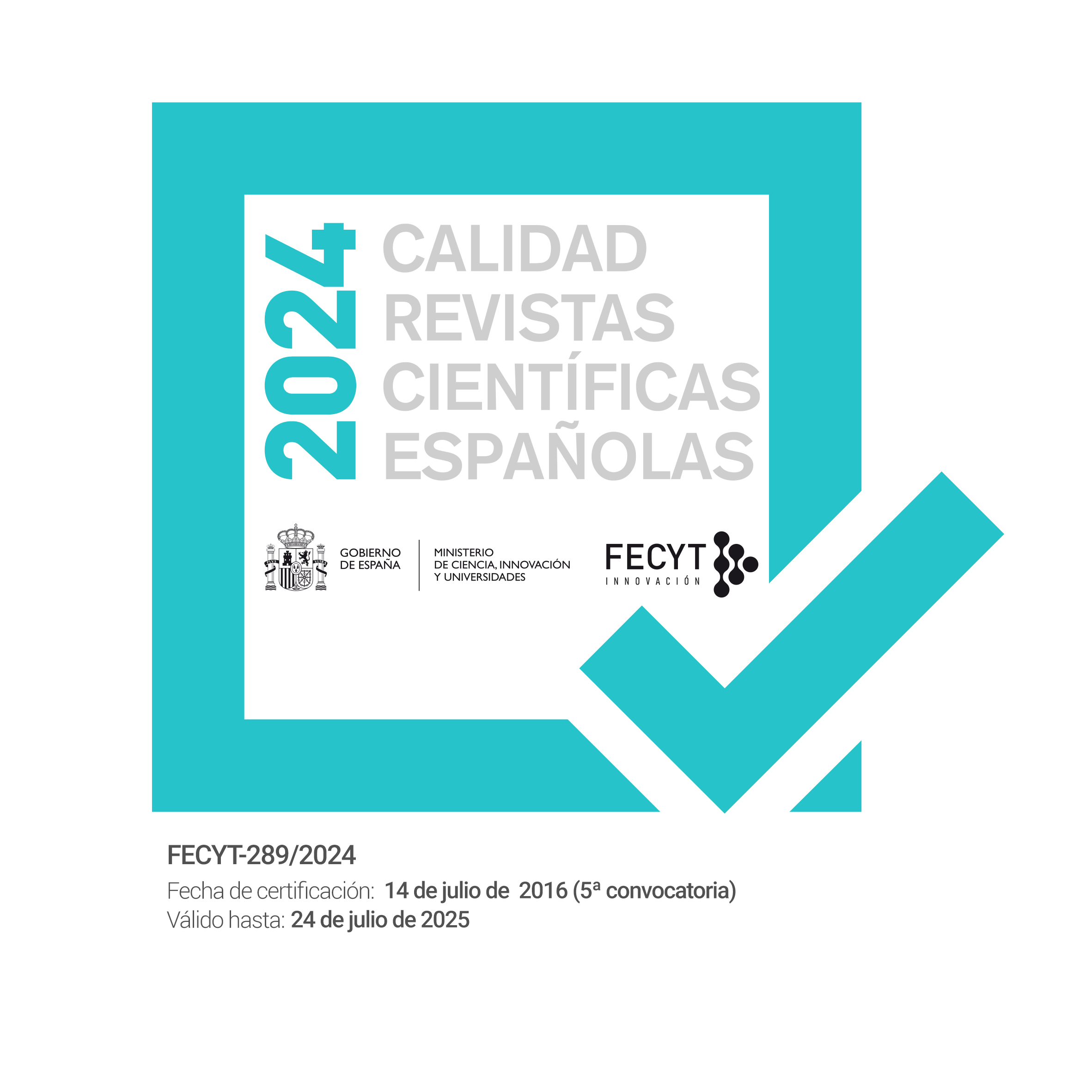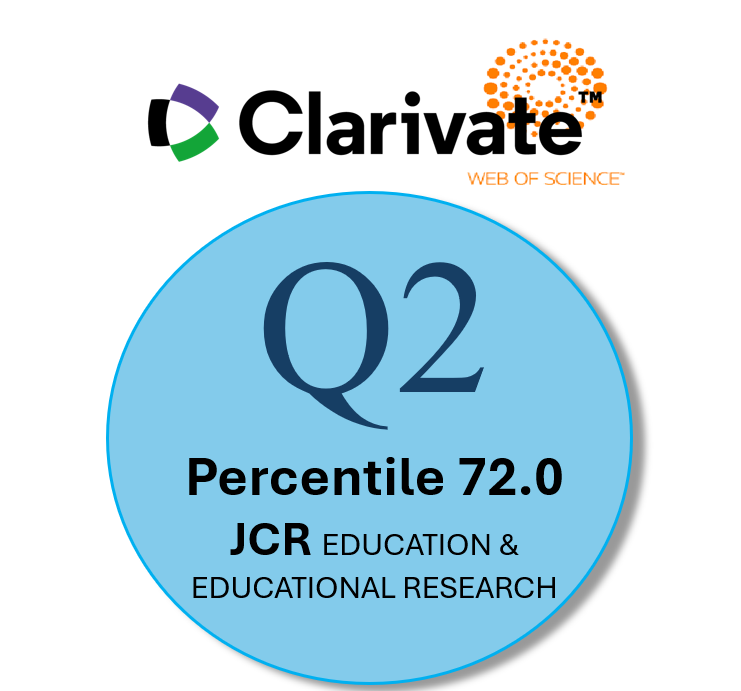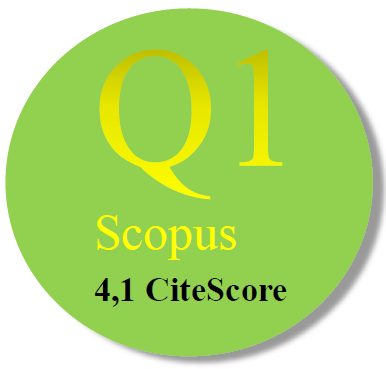Contrasting the experiences of university students in two educational scenarios: online teaching vs. emergency remote teaching
Abstract
The objective of these work was to explore the experiences of university students about the instructional action in an online teaching setting, before Covid-19, and in emergency remote teaching setting, during the pandemic. For this, a cross sectional-correlational study with non-probabilistic sampling of voluntary participants was carried out; the sample consisted of 301 students enrolled in a Mexican university. To contrast the experiences of the same group of students in the two scenarios, a self-applied Likert-type questionnaire was designed, composed of 24 items; the data analysis was performed calculating percentage frequencies, and in addition Student's t test was applied for related samples. It was found that the means were higher for the online teaching scenario compared to the emergency remote teaching scenario, although statistically significant differences were only found regarding the instructional design, the evaluation of learning and the participation of students in the subjects. The results also reveal a couple of methodological limitations and, at the same time, a set of questions that open future lines of work.
Downloads
-
Abstract4349
-
PDF (Español (España))3070
References
Ahmed, F., Zviedrite, N., y Uzicanin, A. (2018). Effectiveness of workplace social distancing measures in reducing influenza transmission: a systematic review. BMC Public Health, 18, 518. https://doi.org/10.1186/s12889-018-5446-1
Alvarado, M. A. (2014). Retroalimentación en educación en línea: una estrategia para la construcción del conocimiento. Revista Iberoamericana de Educación a Distancia, 17(2), 59-73.https://doi.org/10.5944/ried.17.2.12678
Álvarez, G. (2020, 16 de abril). Covid-19. Cambiar de paradigma educativo. Consejo Mexicano de Investigación Educativa (COMIE). http://www.comie.org.mx/v5/sitio/2020/04/16/covid-19-cambiar-de-paradigma-educativo/
Barberà, E. (2016). Aportaciones de la tecnología a la e-Evaluación. Revista de Educación a Distancia (RED), 50, 4. http://www.um.es/ead/red/50
Bloom D., y Cadarette, D. (2019). Infectious disease threats in the twenty-first century: strengthening the global response. Frontiers in immunology, 10, 549. https://doi.org/10.3389/fimmu.2019.00549
Bolliger, D., y Wasilik, O. (2009). Factors influencing faculty satisfaction with online teaching and learning in higher education. Distance Education, 30(1), 103-116. http://doi.org/10.1080/01587910902845949
Booth, P., Guinmard, I., y Lloyd, E. (2017). The perceptions of a situated learning experience mediated by novice teachers' autonomy. The EUROCALL Review, 25(1), 76-91. https://doi.org/10.4995/eurocall.2017.7081
Bozkurt, A., y Sharma, R. (2020). Emergency remote teaching in a time of global crisis due to CoronaVirus pandemic. Asian Journal of Distance Education, 15(1), i-vi. https://doi.org/10.5281/zenodo.3778083
Brown, S., Tai., Bailey, R., Cooley, P., Wheaton, W., Potter, M., Voorhees, R., LeJeune, M., Grefenstette, J., Burke, D., McGlone S., y Lee, B. (2011). Would school closure for the 2009 H1N1 influenza epidemic have been worth the cost?: a computational simulation of Pennsylvania. BMC Public Health, 11(1), 353. https://doi.org/10.1186/1471-2458-11-353
Buerger, C., y Harris, D. (2015). How Can Decentralized Systems Solve System-Level Problems? An Analysis of Market-Driven New Orleans School Reforms. American Behavioral Scientist, 59(10), 1246-1262. https://doi.org/10.1177/0002764215591182
Carlo, J. T., y Chung, W. (2009). Review of schoolclosure as a pandemic mitigation strategy. Texas medicine, 105(7), 21-26. https://www.texmed.org/template.aspx?id=7808
Cervantes, E., y Gutierrez, P. (2020). Resistir la Covid-19. Intersecciones en la Educación de Ciudad Juárez, México. Revista Internacional de Educación para la Justicia Social, 9(3), 7-23. https://doi.org/10.15366/riejs2020.9.3.001
Chan, K. (2005). Control of severe acute respiratory syndrome in Singapore. Environmental health and preventive medicine, 10(5), 255-259. https://doi.org/10.1007/BF02897699
Comas, A., De los Arcos, B., y Mardomingo, R. (2012). Virtual Learning Environments (VLEs) for distance language learning: shifting tutor roles in a contested space for interaction. Computer Assisted Language Learning, 25(2), 129-143. https://doi.org/10.1080/09588221.2011.636055
Compton, L. (2009). Preparing language teachers to teach language online: a look at skills, roles, and responsibilities. Computer Assisted Language Learning, 22(1), 73-99. https://doi.org/10.1080/09588220802613831
Daniel, S. (2020). Education and the COVID-19 pandemic. Prospects. https://doi.org/10.1007/s11125-020-09464-3
Dorrego, E. (2016). Educación a distancia y evaluación del aprendizaje. Revista de Educación a Distancia (RED), 50, 12. https://revistas.um.es/red/article/view/271241
Esnard, A., Lai, B. S., Wyczalkowski, C., Malmin, N., y Shah, H. (2018). School vulnerability to disaster: examination of school closure, demographic, and exposure factors in Hurricane Ike’s winds wath. Natural Hazards, 90(2), 513-535. https://doi.org/10.1007/s11069-017-3057-2
Fernández, M., Herrera, L., Hernández, D., Nolasco, R. y de la Rosa, R. (2020, 1 de abril). Lecciones del Covid-19 para el sistema educativo mexicano. Distancia por tiempos. Blog de educación. https://educacion.nexos.com.mx/?p=2228
Fox, R. (2004). SARS epidemic: Teachers’ experiences using ICTs. En R. Atkinson, C. McBeath, D. Jonas-Dwyer y R. Phillips (Eds.), Beyond the confort zone: Proceedings of the 21st ASCILITE Conference (pp. 319-327). ASCILITE. http://www.ascilite.org.au/conferences/perth04/procs/fox.html
García, F., Corell, A., Abella, V., y Grande, M. (2020). La evaluación online en la educación superior en tiempos de la COVID-19. Education in the Knowledge Society, 21, 12. http://doi.org/10.14201/eks.23013
Glenn (2020, 7 de mayo). From Emergency Remote Teaching to Rigorous Online Learning. EdTech: Focus on Higher Education. https://edtechmagazine.com/higher/article/2020/05/emergency-remote-teaching-rigorous-online-learning-perfcon
Halder, N., Kelso, J. K., y Milne, G. J. (2010). Developing guidelines for school closure interventions to be used during a future influenza pandemic. BMC Infectious Diseases, 10, 221. https://doi.org/10.1186/1471-2334-10-221
Hernández, R., Fernández, C., y Baptista, M. (2014). Metodología de la investigación (6ª ed.). México: McGraw-Hill.
Hodges, C., Moore, S., Locke, B., Trust, T., y Bond, A. (2020, 27 de marzo). The Difference Between Emergency Remote Teaching and Online Learning. EDUCAUSE. https://er.educause.edu/articles/2020/3/the-difference-between-emergency-remote-teaching-and-online-learning
Houston, M. (2017). The Experiences of Faculty and Staff at Academic Institutions Preparing Themselves for Academic Continuity after a Disaster: A Phenomenological Study. International Journal of Business and Social Science, 8(7), 7-18. http://ijbssnet.com/journals/Vol_8_No_7_July_2017/2.pdf
Huremovic, D. (2019). Social Distancing, Quarantine, and Isolation. En D. Huremovic (ed.), Psychiatry of Pandemics (pp. 85-94). Springer. https://doi.org/10.1007/978-3-030-15346-5_8
Innes, R. (2020, 7 de abril). The Corona Virus and ‘Emergency Remote Teaching’ - The Data. Bluegrass Institute for Public Policy Solutions (BIPPS). http://www.bipps.org/the-corona-virus-and-emergency-remote-teaching-the-data/
Meyer, K. A., y Wilson, J. L. (2011). The Role of Online Learning in the Emergency Plans of Flagship Institutions. Online Journal of Distance Learning Administration, 14(1). https://www.learntechlib.org/p/52628/
Moreno, O., y Cárdenas, M. G. (2012). Educación a distancia: nueva modalidad, nuevos alumnos. Perfiles de alumnos de Psicología en México. Perfiles educativos, 34(136), 118-136. https://doi.org/10.22201/iisue.24486167e.2012.136.31767
Muller, L., y Goldenber, G. (2020). Education in times of crisis: The potential implications of school closures for teachers and students. Chartered College of Teaching. https://my.chartered.college/wp-content/uploads/2020/05/CCTReport150520_FINAL.pdf
Murphy, M. (2020). COVID-19 and emergency eLearning: Consequences of the securitization of higher education for post-pandemic pedagogy. Contemporary Security Policy, 41(3), 492-505. https://doi.org/10.1080/13523260.2020.1761749
Mutch, C. (2017). Winners and losers: School closures in post-earthquake Canterbury and the dissolution of community. Waikato Journal of Education, 22(1), 73-95. https://doi.org/10.15663/wje.v22i1.543
Niño, S., Castellanos-Ramírez, J. C., y Viloria, E. (2019). Construcción del conocimiento y regulación del aprendizaje en tareas colaborativas asíncronas. Apertura: Revista de Innovación Educativa, 11(1), 6-23. https://doi.org/10.32870/Ap.v11n1.1465
Organización de las Naciones Unidas para la Educación, la Ciencia y la Cultura [UNESCO]. (2020a). Impacto de COVID-19 en la educación. UNESCO. https://es.unesco.org/covid19/educationresponse
Organización de las Naciones Unidas para la Educación, la Ciencia y la Cultura [UNESCO]. (2020b, 24 de abril). Surgen alarmantes brechas digitales en el aprendizaje a distancia. UNESCO. https://es.unesco.org/news/surgen-alarmantes-brechas-digitales-aprendizaje-distancia
Pang, X., Zhu, Z., Xu, F., Guo, J., Gong, X., Liu, D., Liu, Z., Chin, D. P., y Feikin, D. R. (2003). Evaluation of control measures implemented in the severe acute respiratory syndrome outbreak in Beijing, 2003. Journal of the American Medical Association, 290(24), 3215-3221. https://doi.org/10.1001/jama.290.24.3215
Park, J., y Luo, H. (2017). Refining a Competency Model for Instructional Designers in the Context of Online Higher Education. International Education Studies, 10(9), 87-98. https://doi.org/10.5539/ies.v10n9p87
Quinn, S. C., y Kumar, S. (2014). Health in equalities and infectious disease epidemics: a challenge for global health security. Biosecurity and Bioterrorism: Biodefense Strategy, Practice, and Science, 12(5), 263-273. https://doi.org/10.1089/bsp.2014.0032
Rhea, R. (2003). Online Learning Fills Void in Nations Coping With SARS. Education Week, 22(37). 1-6 https://www.edweek.org/ew/articles/2003/05/21/37sars.h22.html
Rodriguez, V. R., y Gallardo, K. E. (2019). Decisiones en evaluación: ambientes virtuales de posgrado, un estudio ex post-facto. Revista de Educación a Distancia (RED), 19(59). https://doi.org/10.6018/red/59/06
Rozitis, C. (2017). Instructional Design Competencies for Online High School Teachers Modifying their own Courses. TechTrends, 61(5), 428-437. https://doi.org/10.1007/s11528-017-0204-2
Sánchez, M., Martínez, A., Torres, R., Servín, M., Hernández, A., Benavides, M., Rendón,V., y Jaimes, C. (2020). Retos educativos durante la pandemia de COVID-19: una encuesta a profesores de la UNAM. Revista Digital Universitaria, 21(3), 1-24. https://www.revista.unam.mx/wp-content/uploads/a12.pdf
Satpathy, B. y Ali, E. (2020). A study on psychological well-being of final year management students during COVID-19 pandemic lockdown in India. International Journal of Indian Psychology, 8(2), 1-25. https://ijip.in/pdf-viewer/?id=21210
Shintani, N. (2016). The effects of computer-mediated synchronous and asynchronous direct corrective feedback on writing: a case study. Computer Assisted Language Learning, 29(3), 517-538. https://doi.org/10.1080/09588221.2014.993400
Viner, R., Russell, S., Croker, H., Packer, J., Ward, J., Stansfield, C., Mytton, O., Bonell, C., y Booy, R. (2020). School closure and management practices during coronavirus outbreaks including COVID-19: a rapid systematic review. The Lancet Child & Adolescent Health, 4(5), 397-404. https://doi.org/10.1016/S2352-4642(20)30095-X
Watson, F., Castano, M., y Ferdinand, D. (2017). Instructional Strategies to Help Online Students Learn: Feedback from Online Students. TechTrends, 61(5), 420-427. https://doi.org/10.1007/s11528-017-0216-y
Organización Mundial de la Salud [OMS]. (2009, 11 de septiembre). Measures in school settings. Pandemic (H1N1) 2009 briefing note 10. World Health Organization. https://www.who.int/csr/disease/swineflu/notes/h1n1_school_measures_20090911/en/
- 08-01-2021 (2)
- 28-08-2020 (1)
Las obras que se publican en esta revista están sujetas a los siguientes términos:
1. El Servicio de Publicaciones de la Universidad de Murcia (la editorial) conserva los derechos patrimoniales (copyright) de las obras publicadas, y favorece y permite la reutilización de las mismas bajo la licencia de uso indicada en el punto 2.
2. Las obras se publican en la edición electrónica de la revista bajo una licencia Creative Commons Reconocimiento-NoComercial-SinObraDerivada 3.0 España (texto legal). Se pueden copiar, usar, difundir, transmitir y exponer públicamente, siempre que: i) se cite la autoría y la fuente original de su publicación (revista, editorial y URL de la obra); ii) no se usen para fines comerciales; iii) se mencione la existencia y especificaciones de esta licencia de uso.
3. Condiciones de auto-archivo. Se permite y se anima a los autores a difundir electrónicamente las versiones pre-print (versión antes de ser evaluada) y/o post-print (versión evaluada y aceptada para su publicación) de sus obras antes de su publicación, ya que favorece su circulación y difusión más temprana y con ello un posible aumento en su citación y alcance entre la comunidad académica. Color RoMEO: verde.













